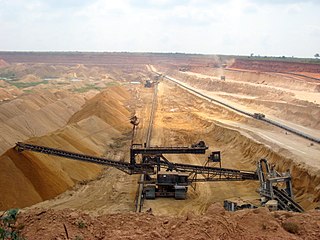Related Research Articles

The economy of Bhutan is based on agriculture and forestry, which provide the main livelihood for more than 60% of the population. Agriculture consists largely of subsistence farming and animal husbandry. Rugged mountains dominate the terrain and make the building of roads and other infrastructure difficult. Bhutan is among the richest by gross domestic product (nominal) per capita in South Asia, at $3,491 as of 2022, but it still places 153rd, and among the poorest in the world. The total gross domestic product is only $2,653 million, and 178th according to IMF.

The economy of Eritrea has undergone extreme changes after the War of Independence. It experienced considerable growth in recent years, indicated by an improvement in gross domestic product in 2011 of 8.7 percent and in 2012 of 7.5% over 2011, and has a total of $8.090 billion as of 2020. However, worker remittances from abroad are estimated to account for 32 percent of gross domestic product.

Gross domestic product (GDP) is a monetary measure of the market value of all the final goods and services produced and rendered in a specific time period by a country or countries. GDP is often used to measure the economic health of a country or region. Several national and international economic organizations maintain definitions of GDP, such as the OECD and the International Monetary Fund.

The economy of Malawi is $7.522 billion by gross domestic product as of 2019, and is predominantly agricultural, with about 80% of the population living in rural areas. The landlocked country in south central Africa ranks among the world's least developed countries and poorest countries. Approximately 50% of the population lives below the national poverty line, with 25% living in extreme poverty.

The economy of Togo has struggled greatly. The International Monetary Fund (IMF) ranks it as the tenth poorest country in the world, with development undercut by political instability, lowered commodity prices, and external debts. While industry and services play a role, the economy is dependent on subsistence agriculture, with industrialization and regional banking suffering major setbacks.

The economy of Yemen has significantly weakened since the breakout of the Yemeni Civil War and the humanitarian crisis, which has caused instability, escalating hostilities, and flooding in the region. At the time of unification, South Yemen and North Yemen had vastly different but equally struggling underdeveloped economic systems. Since unification, the economy has been forced to sustain the consequences of Yemen's support for Iraq during the 1990–91 Persian Gulf War: Saudi Arabia expelled almost 1 million Yemeni workers, and both Saudi Arabia and Kuwait significantly reduced economic aid to Yemen. The 1994 civil war further drained Yemen's economy. As a consequence, Yemen has relied heavily on aid from multilateral agencies to sustain its economy for the past 24 years. In return, it has pledged to implement significant economic reforms. In 1997 the International Monetary Fund (IMF) approved two programs to increase Yemen's credit significantly: the enhanced structural adjustment facility and the extended funding facility (EFF). In the ensuing years, Yemen's government attempted to implement recommended reforms: reducing the civil service payroll, eliminating diesel and other subsidies, lowering defense spending, introducing a general sales tax, and privatizing state-run industries. However, limited progress led the IMF to suspend funding between 1999 and 2001.
A variety of measures of national income and output are used in economics to estimate total economic activity in a country or region, including gross domestic product (GDP), Gross national income (GNI), net national income (NNI), and adjusted national income. All are specially concerned with counting the total amount of goods and services produced within the economy and by various sectors. The boundary is usually defined by geography or citizenship, and it is also defined as the total income of the nation and also restrict the goods and services that are counted. For instance, some measures count only goods & services that are exchanged for money, excluding bartered goods, while other measures may attempt to include bartered goods by imputing monetary values to them.
The gross world product (GWP), also known as gross world income (GWI), is the combined gross national income of all the countries in the world. Because imports and exports balance exactly when considering the whole world, this also equals the total global gross domestic product (GDP). According to the World Bank, the 2013 nominal GWP was approximately 75.59 trillion United States dollars. In 2017, according to the CIA's World Factbook, the GWP was around $80.27 trillion in nominal terms and totaled approximately 127.8 trillion international dollars in terms of purchasing power parity (PPP). The per capita PPP GWP in 2017 was approximately 17,500 international dollars according to the World Factbook. According to the World Bank, the 2020 GWP in current dollars was approximately $84.705 trillion.

The economy of the Gambia is heavily reliant on agriculture. The Gambia has no significant mineral or other natural resources, and has a limited agricultural base. About 75% of the population depends on crops and livestock for its livelihood. Small-scale manufacturing activity features the processing of peanuts, fish, and animal hides.

The world economy or global economy is the economy of all humans in the world, referring to the global economic system, which includes all economic activities conducted both within and between nations, including production, consumption, economic management, work in general, financial transactions and trade of goods and services. In some contexts, the two terms are distinct: the "international" or "global economy" is measured separately and distinguished from national economies, while the "world economy" is simply an aggregate of the separate countries' measurements. Beyond the minimum standard concerning value in production, use and exchange, the definitions, representations, models and valuations of the world economy vary widely. It is inseparable from the geography and ecology of planet Earth.

The economy of North America comprises more than 596 million people in its 24 sovereign states and 15 dependent territories. It is marked by a sharp division between the predominantly English speaking countries of Canada and the United States, which are among the wealthiest and most developed nations in the world, and countries of Central America and the Caribbean in the former Latin America that are less developed. Mexico and Caribbean nations of the Commonwealth of Nations are between the economic extremes of the development of North America.

The food industry is a complex, global network of diverse businesses that supplies most of the food consumed by the world's population. The food industry today has become highly diversified, with manufacturing ranging from small, traditional, family-run activities that are highly labour-intensive, to large, capital-intensive and highly mechanized industrial processes. Many food industries depend almost entirely on local agriculture, animal farms, produce, and/or fishing.
Gross regional domestic product (GRDP), gross domestic product of region (GDPR), or gross state product (GSP) is a statistic that measures the size of a region's economy. It is the aggregate of gross value added (GVA) of all resident producer units in the region, and analogous to national gross domestic product. The GRDP includes regional estimates on the three major sectors including their sub-sectors, namely:

The secretary of agriculture of Iowa is an elected position in government of the U.S. state of Iowa that was created in 1923 by the extra session of the 40th General Assembly. The secretary of agriculture heads the Iowa Department of Agriculture and Land Stewardship, which is responsible for managing land and helping farmers in the state.
The Consumer support estimate (CSE) is an OECD indicator of the annual monetary value of gross transfers to (from) consumers of agricultural commodities, measured at the farm gate level, arising from policy measures which support agriculture, regardless of their nature, objectives or impacts on consumption of farm products. The CSE can be expressed in monetary terms; as a ratio to the value of consumption expenditure valued at farm gate prices, including budgetary support to consumers ; or as a ratio to the value of consumption expenditure valued at world market prices, without budgetary support to consumers.
The producer support estimate (PSE) is an indicator of the annual monetary value of gross transfers from consumers and the state to agricultural producers, measured at the farm gate level, arising from policy measures that support agriculture, regardless of their nature, objectives or impacts on farm production or income. Examples include market price support, and payments based on output, area planted, animal numbers, inputs, or farm income. PSEs, which are updated and published annually by the Organisation for Economic Co-operation and Development, can be expressed in monetary terms: as a ratio to the value of gross farm receipts valued at farm gate prices, including budgetary support ; or, as a ratio to the value of gross farm receipts valued at world market prices, without budgetary support.
Market price support (MPS) is an indicator, developed by the OECD, used in the calculation of Producer and Consumer Subsidy Equivalents (PSE/CSE). The PSE and CSE acronyms were changed in 1999 to Producer and Consumer Support Estimate. MPS is the annual monetary value of gross transfers from consumers and taxpayers to agricultural producers arising from policy measures creating a gap between domestic market prices and border prices of a specific agricultural commodity measured at the farm gate level. Conditional on the production of a specific commodity, MPS includes the transfer to producers associated with both production for domestic use and exports and is measured by the price gap applied to current production. The MPS is net of producer levies on sales of the specific commodity or penalties for not respecting regulations such as production quotas. In the case of livestock production MPS is net of the market price support on domestically produced coarse grains and oilseeds used as animal feed.
In United States agricultural policy, gross farm income refers to the monetary and non-monetary income received by farm operators. Its main components include cash receipts from the sale of farm products, government payments, other farm income, value of food and fuel produced and consumed on the same farm, rental value of farm dwellings, and change in value of year-end inventories of crops and livestock.
The General Services Support Estimate (GSSE) is an Organisation for Economic Co-operation and Development (OECD) indicator of the annual monetary value of gross transfers of general services provided to agriculture collectively, arising from policy measures that support agriculture, regardless of their nature, objectives and impacts on farm production, income, or consumption of farm products. Examples include research and development, education, infrastructure, and marketing and promotion programs. The GSSE can be expressed in monetary terms or as a percentage of the total support to agriculture.
Farmers' markets are markets in which producers sell directly to consumers. While farmers' markets do not have a measurable impact on the United States economy as a whole, many studies have found that farmers' markets impact state and municipal economies as well as vendors, local businesses, and consumers. These impacts are measured using the IMPLAN Input-Output Model and the Sticky Economic Evaluation Device (SEED), in addition to other methods. The economic impacts that are most frequently measured include effects on the revenue and income of local growers and local businesses, the effects on job creation, and the effects on other sectors of state and local economies. Some obstacles that may reduce impact or create negative economic effects include over-saturation, socioeconomic barriers, the opportunity cost of farmers' markets, and the projected unsustainable growth of farmers' markets in the United States.
References
 This article incorporates public domain material from Jasper Womach. Report for Congress: Agriculture: A Glossary of Terms, Programs, and Laws, 2005 Edition (PDF). Congressional Research Service.
This article incorporates public domain material from Jasper Womach. Report for Congress: Agriculture: A Glossary of Terms, Programs, and Laws, 2005 Edition (PDF). Congressional Research Service.